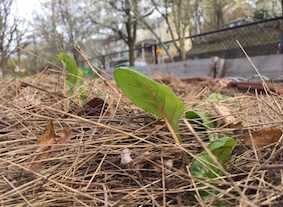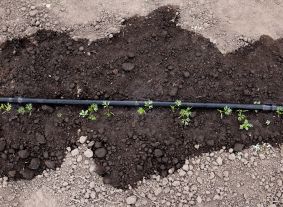Strategies for a Successful Early Spring
Views: 4708

There are many things you can be sure will happen in the spring garden. It’ll be chilly. It’ll also be warm. The garden is bug free. Bugs will also be coming out in full force. You’ll have a weed-free working space. And you’ll have a ton of weeds not only coming up, but also coming into flower. All of this is to say, you’ll find it all in the spring garden: bugs, weeds, hard and cold soil, and soil that is pleasantly warming with longer, more pleasant days.
Each spring presents me with two problems, and I’ve developed two strategies to deal with them.
First problem: The days are variable in temperatures, almost to an extreme. One day can be 80F, and that evening the temperatures can drop into the mid 30s. It’s hard to know what to do. You don’t want to NOT take advantage of warm weather in the garden. But, you also want to protect plants from chill. Seedlings I want to get into the garden early, such as chard or even cold-sensitive basil, either don’t grow well or are damaged by cold weather.
My solution: Straw mulch, or in my case, salt marsh hay mulch. After planting the seedlings or small plants, I pile the mulch loosely around the entire plant, up to its top leaves, nearly covering them. This regulates the temperatures around the plant. While it may take longer for the plant and ground to warm up with straw mulch around it, it’ll also cool off more slowly.
Second problem: Early-spring insect predators. When I plant seeds of chard in the garden, spinach or kale in early spring, they emerge from the ground just about the same time that their insect predators emerge. Flea beetles munch on the very small kale and other cabbage family seedlings just as they are emerging, literally mowing them down and ruining their chances of survival. For spinach and chard, it’s the leaf miners that attach when the leaves begin to form.
My solution: Instead of sowing seeds of these spring crops I plant larger seedlings or transplants. This gives the plants several weeks to grow before the insects that feed on them emerge. The crops will still sustain some damage. However, the damage done by 10 flea beetles on a 0.5 inch leaf is way worse than the damage they’ll do on a 5 inch leaf!
Why not use floating row covers or a cold frame to keep the crops warmer? I’m afraid the warmer soil will trigger the pests to emerge from the ground and they’ll be trapped inside. Irrational fear? I’m telling you, leaf miners and flea beetles have driven me to it!
Meet Ellen Wells
When you’re raised on a farm, you can’t help but know a thing or two about gardening. Ellen Wells is our expert on edible gardening.…
Ellen's Recent Posts

Asparagus






